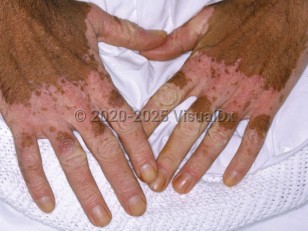Chemical leukoderma (also known as contact leukoderma or occupational vitiligo) is an acquired depigmenting dermatosis caused by repeated or sometimes a single exposure to specific chemicals. These substances may be toxic to melanocytes, or may compete with tyrosine for hydroxylation by tyrosinase, thereby impeding synthesis of melanin in melanocytes.
The following set of diagnostic criteria has been proposed (3 of 4 criteria must be present for the diagnosis):
- Acquired depigmented macules and patches that resemble vitiligo
- A history of repeat exposure to a causative chemical
- Depigmentation occurs at sites of exposure
- The presence of confetti macules
Chemicals in the phenol and catechol families are the most widely recognized causative agents, including monobenzyl ether of hydroquinone found in some "acid-cured" rubber gloves, germicides such as para-tertiary butylphenol (PTBP), and pyrethroid insecticides. An adhesive (hexamethylenetetramine) has also been implicated. Other causative toxins include mercurials, arsenics, sulfhydryls, azo dyes, and paraphenylenediamine (PPD). Exposure to these types of agents typically occurs in an industrial setting. Additionally, they can be found in many common household materials, including wallets, decorative coloring agents for skin, footwear, watchstraps, hearing aids, deodorants, hair treatments, cosmetics, eyewear, and detergents.
Chemical leukoderma is common in developing countries where manufacture of consumer products often is not strictly regulated. In developed countries, exposure to causative agents more commonly takes place in industrial occupations.
Chemical leukoderma can affect any age group but is far more prevalent in adults; however, pediatric cases have been reported in developing countries, where children have repeated exposure to common household objects containing the chemical agent.
Individuals with a personal or family history of vitiligo have a higher risk of developing chemical leukoderma on exposure to causative chemicals.
Related topic:
drug-induced hypopigmentation


